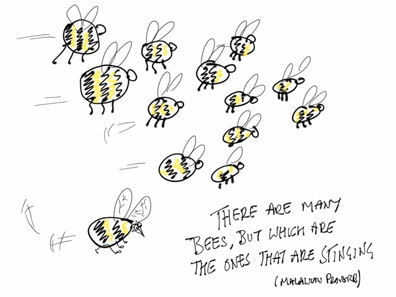Section 06: Gathering information and analysing together
To find the strategy sweet spot requires hearing different perspectives on how the environment, needs and vision are changing; on what the NGO is best at; and on what they can resource with people and money. In an increasingly digital world, there are a wide variety of media for doing this, whether WhatsApp or Zoom calls, or collaborative tools like Mural or Google Jamboard. Technological advances afford new opportunities for hearing from a wide variety of people, taking an open strategy approach.
6.1 How to gather information
There are obviously many different methods for gathering data for a strategic planning process, including:
Document review such as any programme evaluations (particularly participatory ones that identify beneficiaries’ perspectives); past strategy documents; reports to funders, minutes of leadership/board meetings.
Semi-structured interviews with key informants are a powerful way of gathering individual perspectives from both internal and external stakeholders. It helps to have a set of key questions to adapt and ask respondents.
Focus group discussions are a good way of hosting a dynamic conversation between different respondents.
Online surveys such as SurveyMonkey can help bring a useful quantification of perspectives and opinions. With advances in technology, if surveys are clear and simple enough, this can help bring the perspectives of those closest to the ground into the boardroom.
INTRAC's M&E Universe has short papers on interviews, focus groups, and surveys and questionnaires.
When gathering data from groups, two commonly used tools for strategy are PESTLE and SWOT.
6.2 PESTLE
In seeking to gather and interpret information about changes in the wider environment, PESTLE is a commonly used tool. It highlights the importance of identifying trends and anticipating changes in a variety of environments: Political, Economic, Social, Technological, Legal, and Environmental.
A clear understanding of the environment could influence an organisation’s vision as well as whether and how to alter their strategy. It can help an organisation (re)position itself in a dynamic context.
You can download a PESTLE template here, or you can create your own.
6.3 SWOT analysis
The single most familiar tool for developing strategy is the SWOT analysis (the letters represent Strengths, Weaknesses, Opportunities, and Threats). The purpose of the SWOT analysis is to assess the organisation and its external environment and identify the forces that are likely to help and hinder its ability to achieve its mission. In conducting a SWOT analysis, the NGO needs to consider all aspects of its internal functioning – the organisation’s ‘programme’ (what it does) and its ‘process’ (how it goes about doing it).
You can download a SWOT template here, or you can create your own.
6.4 Focus on the bees that are stinging
It is easy to become overwhelmed by information from so many different perspectives. It is critically important to be able to focus on the most critical issues. At some point it may be worth simply asking: ‘What one thing could this organisation do differently to make more of an impact on achieving its mission?’ Without prioritising, analysis can lead to paralysis. As the Malawian proverb colourfully puts it, “Many, many are the bees, but tell me about the ones that are stinging.”
Last updated


